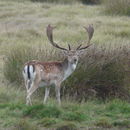Biology
provided by Arkive
Like many species of deer, the fallow deer is active throughout the 24-hour period, but in areas where human disturbance is high, they tend to be more active at night (2). They typically graze on grasses and rushes, but may also browse on young leaves, and also take cereals, berries and acorns (3).
For most of the year, males and females occur in separate single-sex groups, and large herds can aggregate in open areas where there is plenty of food (3). The breeding season, or 'rut' occurs between October and November (3); Males hold 'rutting stands' to defend groups of females (6). Rutting behaviour involves displaying, including groaning contests and parallel walks, escalating to physical contests in which the males lock antlers and push each other (2). One calf is usually produced during June or July (3).
Conservation
provided by Arkive
There is no conservation action targeted at this introduced species.
Description
provided by Arkive
Prized as an ornamental species for many years (3), the fallow deer displays a variety of coat colours in the UK, ranging from red, brown and black, and even pure white coats (6). A black line runs along the back to the tail, and there are often white spots on the back during summer (6). The coat becomes darker and thicker in winter (2), and these white spots become more faint (6). Males have impressive antlers that can measure up to 70 centimetres in height (6). Calves are born with a coat similar to the summer coat of the adult (6).
Habitat
provided by Arkive
This species inhabits mature deciduous and mixed woodland with dense undergrowth (3). It also occurs in marshes, meadows, and mature conifer plantations (3).
Range
provided by Arkive
In the 11th century, the Normans introduced fallow deer to Britain; they are now patchily distributed throughout much of England and Wales, they also occur in some areas of Scotland and Northern Ireland (3). They are common throughout most of Europe, as they have escaped from deer parks throughout the continent (3).
Status
provided by Arkive
This widespread and locally common introduced species is increasing in numbers (3). It is protected in the UK by the Deer Act 1991 (4), and certain methods of killing or capture are prohibited under Appendix IV of the Bern Convention (5).
Threats
provided by Arkive
Road deaths are common, and predation of fawns is a major cause of mortality (3). Populations are managed, as this species is a pest of woodland and agriculture (3).

